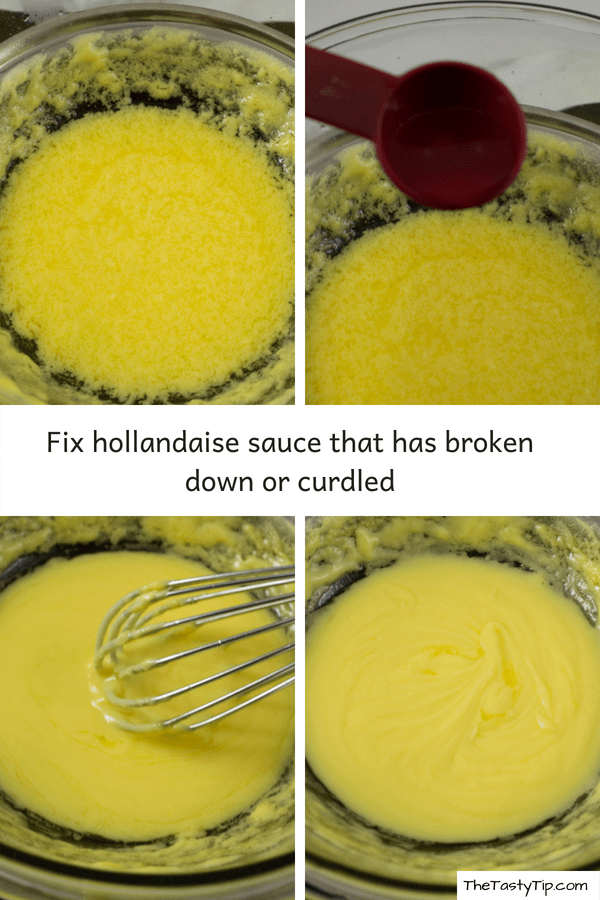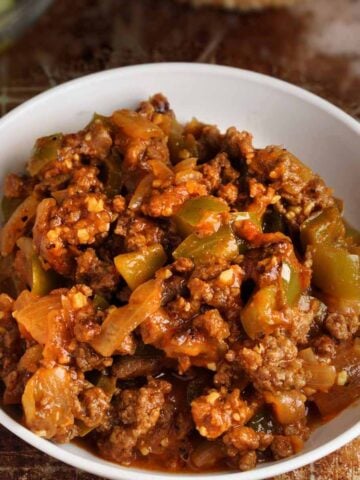Find out why a hollandaise sauce recipe fails and how you can make it work beautifully every time. Get recipe and instructions for classic stove top hollandaise sauce. Learn how to fix hollandaise sauce that has curdled or broken down.

Oh, hollandaise sauce. You can be so dreamy or you can go so very, very wrong. With the flavors of butter and egg yolks balanced with just a hint of lemon, a great hollandaise sauce recipe is creamy and smooth and flows slowly off the spoon to top vegetables, eggs or fish.
Hollandaise sauce, known as one of the five French mother sauces is often the most difficult mother sauce to master.
I found this out the hard way as I used over 4 dozen eggs in my many attempts to get it right. I wanted to make the recipe correctly and I wanted it to be easy. Or at least, not too difficult.
Hollandaise sauce requires patience and the ability to be just a little bit daring. After all, it is difficult to cook the sauce to the magical 160°F, recommended by the US Food and Drug Administration to kill bacteria commonly found in eggs.
But if the sauce is heated too high, it will break apart and curdle. The number one reason hollandaise sauce fails is because it is heated too high or heated too quickly.

If you are looking for something a little healthier, try my healthy hollandaise sauce that tastes the same as classic hollandaise. If you want a quicker recipe, try my 30 second immersion blender hollandaise sauce.
Hollandaise Sauce Ingredients
- Egg yolks
- Water
- Clarified butter
- Lemon juice
- Salt
- White pepper
- Cayenne pepper
How to Make Hollandaise Sauce – A Classic Method
This classic method will require A LOT of whisking. Plan on standing by your stove and babying the sauce.
To better control the cooking temperature, use a double broiler or a bowl over a pan of simmering water. The water should not touch the bowl.

- Bring eggs to room temperature.
- Whisk the egg yolks, lemon juice and water together until it frothy. Continue whisking until the mixture thickens and becomes smooth.

- Add the clarified butter a little at a time and whisk constantly.
- When the sauce is thick and creamy, remove from the heat.
How to Keep Hollandaise Sauce Warm
Hollandaise sauce is a warm sauce, not a hot sauce. It breaks down if it gets too hot. After it is finished, there are a few ways to keep it warm.
- Pour it in a warm pan, cover it with a lid and place the pan on a warming burner
- Keep it in a preheated thermos (tip I learned from Jamie Oliver).
Preheat the thermos by pouring very hot water inside and placing the lid on. Let it sit for 15 minutes. This should be done prior to making the hollandaise sauce.
When the sauce is ready, dump the water from the thermos. Pour in the hollandaise sauce and replace the lid.
What to Serve with Hollandaise Sauce
Hollandaise sauce is well known as the sauce used for eggs Benedict. However, it is also delicious on fish, such as salmon and sole. In addition, it is good on vegetables like asparagus, cauliflower and artichokes.
Hollandaise sauce is typically made in a saucier or a double broiler. A double broiler (or a bowl over a pan of simmering water) helps control the temperature easier.
Hollandaise can break down quickly and curdle if heated too high a temperature. This can happen quickly if you don’t keep a close watch on the sauce.
An Important Note on the Safe Cooking Temperature of Eggs
The US Food and Drug Administration recommends cooking eggs to a temperature of 160°F.
On the other hand, Dr. Terry Simpson, a weight loss surgeon certified in Culinary Medicine, asserts that 130°F is the temperature that salmonella bacteria cannot grow.
He insists that such high cooking temperatures are unneeded and high cooking temperatures interfere with food flavor. So, obviously there are conflicting views on the proper temperature to cook an egg.

In previous trials, where my goal was 160°F, the eggs cooked too fast and the mixture curdled. In my many trials, my hollandaise sauce never reached 160°F.
For this classic hollandaise sauce recipe, I have to be satisfied with a lower temperature for my eggs.
How to Fix Broken/Split/Curdled Hollandaise Sauce

Sometimes your hollandaise sauce will break or split or curdle. These terms all are the same thing. The thick creamy sauce you have been whisking suddenly splits apart and resembles cottage cheese. It is no longer smooth. This happens when the sauce gets too hot, or has been cooking too long at a higher temperature. Fortunately, there is a remedy for this problem.
STEP 1: Remove the pan from the heat.
STEP 2: Pour in 1 to 3 teaspoons and up to 2 tablespoons of warm water.
STEP 3: Whisk water into the sauce. The sauce will begin to thicken again. Place pan over low heat and continue to whisk until thick.
This method has worked well for me. However, for extreme cases it may be necessary to whisk another egg and water over low heat in a separate pan until thick and then slowly mix the new sauce with the old sauce.
How to Store Hollandaise Sauce
This hollandaise sauce recipe can be frozen. To reheat, reheat in a bowl over barely simmering water. Whisk as it warms. Do not overheat or it will curdle.
Please note: hollandaise sauce cannot be refrigerated and then reheated. The butter and eggs will separate creating an oily mess.
I created a healthy hollandaise sauce recipe that has half the butter, was more stable, reached over 160°F and could be refrigerated safely and then reheated. It isn’t the classic version, but it is the one I use most often. Check it out.
The History of Hollandaise Sauce
Before the French Revolution, the French aristocracy employed talented chefs who made culinary delights for them in their homes and palaces. However, after the fall of the aristocracy and the French Revolution, these cooks were out of work.
So the chefs began opening up restaurants and creating their own delicious dishes to attract the new bourgeoisie. These newly empowered French citizens were eager to show their class. Dining on fine cuisine was one way to distinguish their superb taste.
The rising middle class French citizens helped give rise to fine culinary dining and to popularize gastronomy. They were one of the first group of foodies.
The great chefs of the day were popular and admired by the people. As they created new dishes and sauces, they began naming these foods after themselves.
In the early 19th century, Antonin Careme, also known as the father of classic French cooking, identified four fundamental mother sauces (grandes sauces) and their varieties (petite sauces), which were unique sauces that began with one of the grandes sauces.
In the early 20th century in an attempt to simplify and refine sauces, Auguste Escoffier defined 5 mother sauces, still recognized today. These sauces are béchamel, espagnole, veloute, tomate and hollandaise.
Hollandaise is the only one of these sauces made by emulsion. Emulsion is mixing two or more ingredients that are usually unmixable (such as oil and water).
In hollandaise sauce, the egg yolk stabilizes the sauce, allowing the clarified butter to emulsify into the egg yolks.
Did you like this post? Then let's be social. FOLLOW ME on INSTAGRAM and PINTEREST to keep up with the latest happenings.
Recipe

Classic Hollandaise Sauce with Double Boiler
Ingredients
- 3 fresh egg yolks
- 3 tablespoon water
- 2 teaspoon lemon juice freshly squeezed
- ½ cup clarified butter warmed (us in liquid form)
- ¼ teaspoon salt or to taste
- ⅛ teaspoon white pepper or to taste
- pinch 1/16 teaspoon cayenne pepper (or to taste)
Instructions
- BRING eggs to room temperature.
- HEAT water to a simmer in a double boiler. Or use a sauce pan with a glass or silicone bowl over the water.
- CRACK the eggs and separate the egg yolk from the whites. Save the whites for another recipe.
- WHISK egg yolks, water and lemon juice together in top of the double boiler. Mixture will be frothy.
- CONTINUE to whisk for 5 to 10 minutes until the yolk mixture thickens.
- DRIZZLE warm liquid clarified butter into the yolk mixture slowly as you continue to whisk. This will take 3 to 5 minutes.
- STIR in salt, white pepper and cayenne pepper.
- TASTE and adjust seasoning as needed.
- SERVE immediately or freeze in a zip top freezer bag.
- Note: This hollandaise sauce recipe will not reheat after refrigeration. It must either be eaten right away or frozen. To keep it warm for a short time before serving, place in a warming pan with a lid. Or pre-warm a thermos with hot water. Dump the water out and pour hollandaise sauce inside. Place lid on thermos to keep warm.





Comments
No Comments